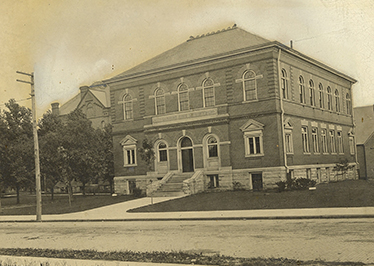
Carnegie Library, early 20th century
Part one of a series on the iconic architecture of campus by Alyssa (Jackson ’19) Bootsma
Frank Hoffman, class of 1961, sat in the Grove City Historical Society and reminisced about his College years. “I remember we had singing classes in Carnegie Center,” he said.
Located at the corner of Main and Broad Streets on what is now called “lower campus,” the Carnegie building has transformed over its 100 years in existence as a Grove City College landmark. In its early years, it was one of just eight College buildings which were located on the lower campus grounds in the heart of the town of Grove City.
What is now Carnegie Alumni Center was once a free library commissioned in 1900 by famed industrialist and philanthropist Andrew Carnegie. The College shared the library with the town of Grove City until 1906, when the College assumed full ownership. Andrew Carnegie believed that the library should fulfill the mind, body and soul and therefore it not only housed a library, but also a gymnasium and a music hall.
In 1907, organ pipes were installed in the music hall, furthering Carnegie’s vision. The Carnegie library served the College until Henry Buhl Library — named for another philanthropist who made his fortune as a merchant — was established in 1954 across Wolf Creek and up the hill on what is known as “upper campus.”
Another important landmark to the College is the aptly named Cunningham House. James Cunningham’s father moved to the area in 1798. He and his brother would eventually build the town of Pine Grove, later Grove City, deriving its name from the use of Pennsylvania pine for construction. The Cunninghams built Pine Grove around their grist mill on Wolf Creek. Another imprint James left was a signature red brick house — a mark of success in the early nineteenth century — along East Main Street that now serves as a guest house for the College. Many famous campus visitors have stayed at Cunningham House such as Dr. Ben Carson, the 2016 Grove City College commencement speaker and former presidential candidate.

Cunningham House
This new town needed a school, which Cunningham also shepherded. In 1876, he and the school’s committee hired Isaac C. Ketler as the principal of the Select School that eventually grew into Pine Grove Normal Academy.
A young man named Joseph Newton Pew was only 18 years old when he taught Isaac Ketler in a one-room schoolhouse near Mercer, Pa. Pew, who grew up on a farm outside of Mercer, went on to be an international gas and oil magnate, co-founding Sun Oil Company in 1886. But Pew turned to support Ketler in 1895 as he was cultivating what is now Grove City College. Pew financially supported the school’s mission, vision and values, and served as chairman of the board of trustees, following in the footsteps of townspeople who came before him as members and chairs of the board.
As a principal of the school, Ketler worked tirelessly to build the College. He died suddenly at age 60 from what a friend would call over-work: “The real disease was seventeen hours a day, the rate of work mentioned in conversation as often reached by him,” according to W.M Ramsay, in his article “An Estimate of the Educational Work of Dr. Isaac Conrad Ketler” originally printed in 1915. The real ailment that caused his death was appendicitis.
Despite his early death, Ketler’s devotion lives on in the fabric of the College today. His legacy is much more than a residence hall title, though Ketler Hall was indeed dedicated to the memory of a great man in June 1932. The student living quarters were one of three buildings erected during the Great Depression, proving the hardiness and perseverance of the College during a difficult era led by the President Dr. Weir C. Ketler, son of Isaac C. Ketler.
The Pew family continues to be memorialized across the campus. What is known commonly as MAP Residence Hall is actually named after Mary Anderson Pew, wife of Joseph Newton Pew, to whom the building was dedicated in 1937. Mary Ethel Pew, the daughter of Mary Anderson and Joseph Newton Pew is also the namesake for another female residence hall that was dedicated in 1982. Mary Ethel was an independent woman who attended Bryn Mawr College in Philadelphia and went on to eventually fund cancer research after her mother passed away from the disease. She served as member of the Board of Trustees from 1949-1979, a position few women held at the time. She also had a lot of say and gifted substantial amounts of her own money to the efforts of the College.
J. Howard Pew, Pew’s second son, also earned an undergraduate degree from Grove City College in 1900 at the age of 18. A bronze statue of J. Howard Pew sits majestically in the Harbison Chapel Garden and the fine arts center bears his namesake, honoring his service as and financial support over a lifetime, including 40 years as chairman of the college’s Board of Trustees.
The Pew family is one of many that maintain a deep connection with Grove City College and give other campus buildings their names: Hopeman, Harbison, Harker and Crawford to name a few.
Today, the College is a highly ranked, national Christian liberal arts and sciences college that equips students to pursue their unique callings through an academically excellent and Christ-centered learning and living experience distinguished by a commitment to affordability and promotion of the Christian worldview, the foundations of a free society and the love of neighbor.
Read the Building a Legacy Series
Part 1: Campus buildings tell College’s story
Part 2: Creating a campus in the community
Part 3: Growth in the midst of the Depression
Part 4: Weathering the war and completing the plan
Part 5: The Surge of the 60s, 70s and 80s
Part 6: The 21st century